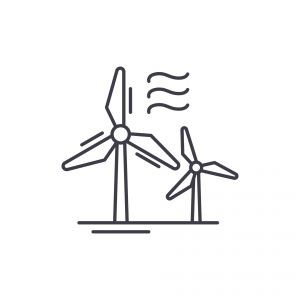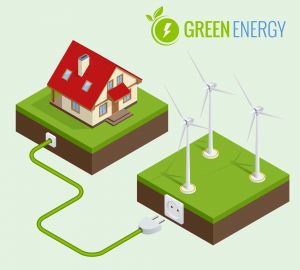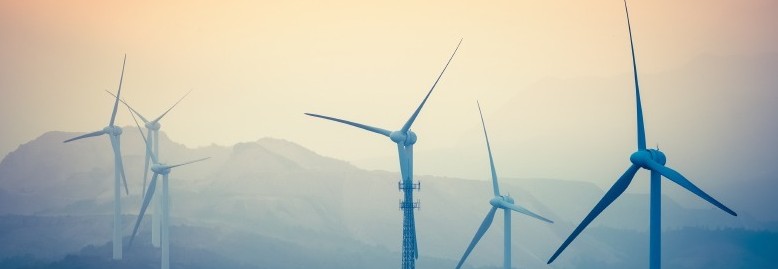If you’ve ever been on a road trip in Australia, chances are you’re probably well acquainted with the sight of wind turbines. These towering structures are more than just landmarks — they’re playing a growing role in the country’s energy mix.
In this article, Canstar Blue breaks down the purpose of wind turbines, highlighting how they work, where you can find them and what contributions they make to renewable energy in Australia through the production of wind power.
On this page:
- What is wind energy?
- How does wind energy work?
- How can wind energy be used?
- How much wind energy is used in Australia?
- Can I sign up to wind power for my home?
- What is the cost of using wind energy?
- What are the advantages of wind energy?
- Are there any disadvantages of wind energy?
- Is wind power the best renewable energy option for Australia?
What is wind energy?
Wind energy is power that has been generated from wind in high hilltop or ocean areas. This type of electricity is created by using wind turbines or windmills, which utilise the wind to operate an electric generator.
Wind power is one of the oldest forms of renewable energy technologies and is continuing to garner popularity alongside other energy sources, like solar or hydroelectricity.
How do wind turbines work?

Wind energy requires wind turbines to generate electricity. Wind turbines need lots of wind exposure to work — this is why they are often built on a hill in rural areas or close to, or even in, the ocean. When in a suitable position, wind currents spin the large turbine blades, which then activate an electric generator inside the system.
Wind turbines are generally placed in clusters along a designated area. These clusters are known as wind farms and are connected to a power substation through underground cables. The electricity generated from these turbines is usually low voltage, but by feeding it to a substation first, the power can be converted to a higher voltage, making it suitable for the grid.
Though wind turbines most commonly take the stock standard windmill style in their presentation, they can be built in different shapes and sizes.
How can wind energy be used?
Wind energy can be used for a number of things, but primarily, it is a source of electricity for the grid or for use on private sites. However, wind power can also be used to pump bore water in rural areas.
How much wind energy is used in Australia?
According to the Clean Energy Council, in 2022 wind generated energy made up 35.6 per cent of Australia’s total clean energy supply, making it one of the country’s leading sources of clean energy generation. Wind power made up 12.8 per cent of the country’s overall electricity generation in 2022, which has been equated to that of powering 6,503,905 homes in a year.

Image: Clean Energy Council, Clean Energy Australia 2023 report.
Some of the biggest wind farm projects that contribute to this capacity include the Stockyard Hill Wind Farm (532MW), Coopers Gap Wind Farm (453MW) and Macarthur Wind Farm (420MW).)
By the end of 2020, Australia’s total installed wind turbine generation capacity was recorded by the Clean Energy Council at 7,376 megawatts (MW). Some of the biggest wind farm projects that contribute to this capacity include the Macarthur Wind Farm (420MW), Sapphire Wind Farm (270MW), Snowtown 2 Wind Farm (270MW) and Ararat Wind Farm (240MW).
How much energy does a wind turbine produce?
According to the NSW Department of Environment, Climate Change and Water, an average wind farm (150 MW) powers 60,000-65,000 homes annually. Larger 500 MW farms can power nearly 200,000 homes.
Can I sign-up to wind power for my home?
While there are ways to get some wind power generated electricity to your home, signing up for purely wind energy at your property isn’t an option — at least not right now. Unless you were to set up and install your own turbine or windmill on your property and go off-grid, there’s no sure-fire way to know if the electricity you are using is 100 per cent wind powered.
That being said, if your home is powered through the grid, chances are you are already accessing a small percentage of wind-powered electricity. If you wanted to invest in green energy, however, you could start contributing to an initiative called GreenPower through your electricity provider. With GreenPower, your retailer can agree to offset some or all of your energy usage by supporting accredited renewable generators like wind farms. This renewable energy can then be fed into the grid on your behalf.
While it doesn’t mean your energy is 100 per cent renewable or wind-powered, since all electricity, no matter how it is generated, is fed into the same grid, it does mean that you’ll be contributing more clean energy sources to the network. Keep in mind, however, that most retailers charge extra for GreenPower.
What is the cost of using wind energy?
According to the Department of Climate Change, Energy, the Environment and Water, wind energy is currently one of the cheapest sources of large-scale renewable energy generation in Australia. The Australian Renewable Energy Agency (ARENA) predicts wind power costs will reduce further over the coming years, as farms continue to grow.
In fact, by 2030, it is believed the cost for a wind farm to deliver electricity to the grid will be below $50 per megawatt hour, according to ARENA.
Related articles:
What are the advantages of wind energy?

There are a few advantages to using wind energy for electricity generation.
- Cleaner energy source: As a renewable energy source, using wind energy can help to reduce carbon emissions in the energy sector.
- Cheaper renewable source: It’s generally cost-effective to generate electricity through a wind farm.
- Safe and dependable: Wind energy has been around for a while, making it quite an established renewable energy source.
- Benefits the economy: Farms and rural areas can lease land for wind farms.
Are there any disadvantages of wind energy?
Despite having many great benefits for electricity generation, there are also some disadvantages to using wind energy.
- Reliant on wind: If the turbines are placed in an area with little to no wind, they may become ineffective.
- Noise pollution: Wind turbines can generate a lot of noise, which can be an issue if they’re built close to animal farmland.
- Require lots of materials and space: Wind turbines are large structures and may require land to be cleared in order to be installed.
Is wind power the best renewable energy option for Australia?
While it’s difficult to determine just what renewable energy source is best, it’s definitely fair to say that wind energy has its perks. Wind is a fairly abundant source in Australia and the cost of maintaining and generating wind energy through turbines is on the cheaper end of the clean energy scale.
Wind energy use in Australia is definitely on the rise. Whether or not this trajectory will continue into the future will depend on how these generators are viewed by invested parties, especially with the upfront costs for construction and general display of turbines still a point of criticism.
In the meantime, however, if you’re looking to bolster your renewable credentials in the energy space, your best bet is to jump onto a GreenPower or carbon neutral energy plan, or install solar panels on your roof. And if you do decide to install solar, or better yet, you already have, be sure to check out our annual solar providers ratings to see which retailers Aussies love for their solar feed-in tariffs.
Image credit: iconim/Shutterstock.com, Clean Energy Council, Golden Sikorka/Shutterstock.com.

Share this article